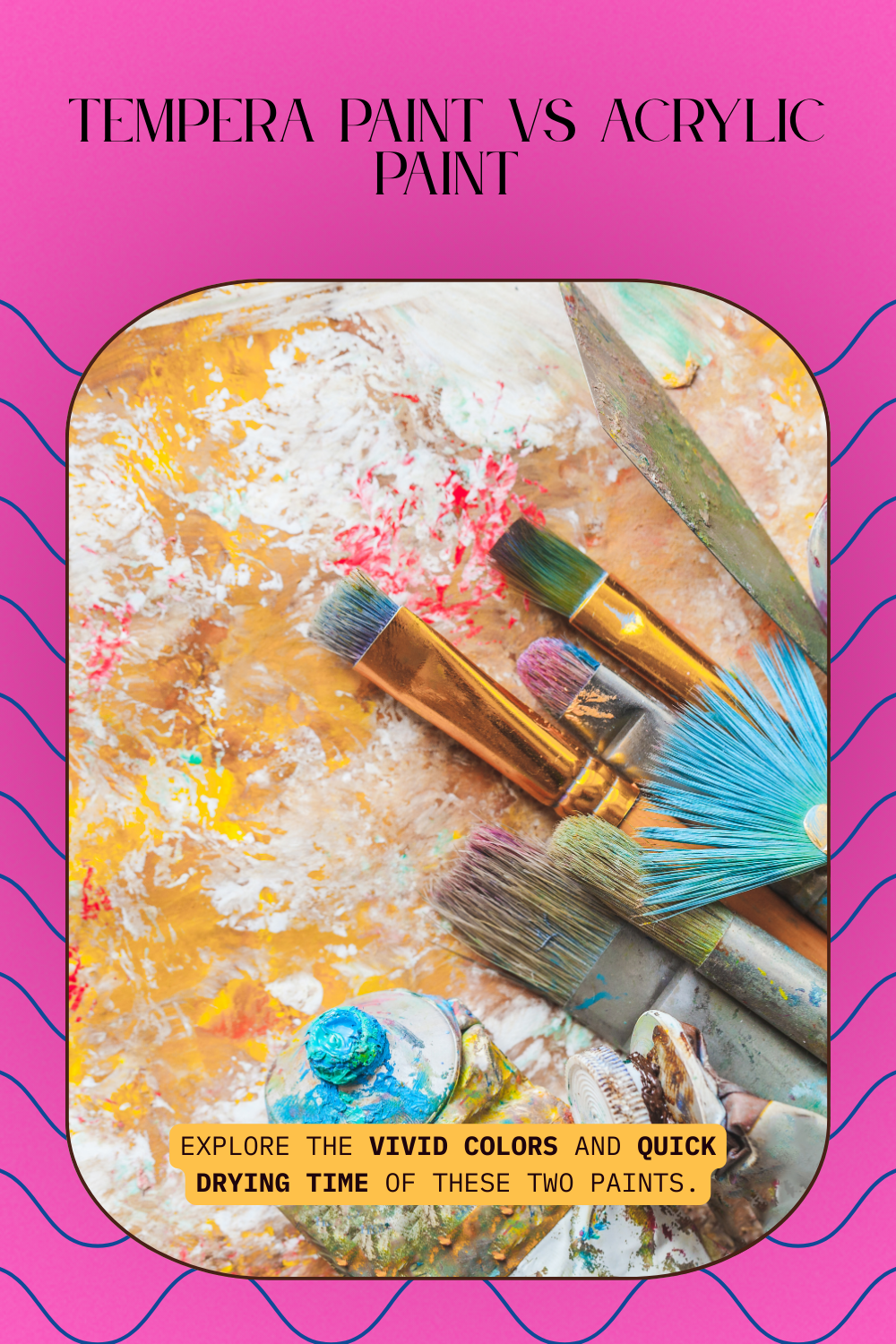Tempera Paint vs Acrylic Paint
Have you ever wandered down the paint aisle, wondering which paint would fit your next creative adventure? I’ve been there, torn between the vibrant allure of tempera paint and the polished versatility of acrylic paint.
Each one holds its own special charm, but that doesn’t mean they serve the same purpose. Over the years, I’ve worked with both extensively, so I’ll share what I’ve learned to help you decide which is better for your project.
If you’re deciding between tempera and acrylic, buckle up because this guide is packed with everything you need to know—from differences and pros and cons to tips and personal experiences.
Hopefully, by the end, you’ll have a clearer blueprint for your next artistic endeavor.
What Exactly Are Tempera and Acrylic Paints?
First, let’s break down what each type of paint is.
Tempera Paint, also referred to as poster or school paint, is a water-based medium that’s been popular for centuries. It’s made from pigments mixed with an agent like binding gum or starch.
Historically, tempera paint was made using egg yolks as a binder (yes, actual eggs!), and artists in ancient Rome and the Renaissance often crafted brilliant masterpieces with it.
While modern tempera paint no longer uses eggs, the essence is the same. It’s bright, quick-drying, and washable, which is why it’s seen in classrooms and kids’ projects.
Acrylic Paint, on the other hand, is the modern all-rounder for many artists and crafters. Introduced in the 20th century, it’s made from pigment suspended in an acrylic resin binder.
When it dries, it becomes durable and water-resistant, which makes it widely trusted for everything from fine arts to home decor.
Both paints are water-based, cost-friendly, and easy to work with, but they deliver completely different results.
Tempera vs Acrylic Paint
The more I’ve experimented with tempera and acrylic, the more I’ve realized just how distinct they are. Here’s where the differences truly show:
1. Finish and Appearance
- Tempera Paint: Tempera paint dries to a flat, matte finish. Its colors are vibrant but not particularly rich or deep. Due to its powdery texture, the dried look can feel chalky. While I love how tempera pops for certain crafts, it can lack the dimension I often want for more refined pieces.
- Acrylic Paint: Acrylic paint offers incredible versatility when it comes to finish. Depending on the formula, you can get a range of looks, from matte to ultra-glossy. This feature has made me reach for acrylic whenever I need that polished, professional touch. The colors are bold and stay that way even after they dry, adding depth and texture.
2. Durability
- Tempera Paint: Durability is not tempera’s strong point. Once it dries, tempera stays water-soluble, so even a splash of moisture can ruin your work. If you’re creating something temporary or disposable, tempera works great. One time, I painted a large banner for an event using tempera, but as soon as we moved it to a slightly damp area, colors started bleeding. Lesson learned!
- Acrylic Paint: Acrylic, on the other hand, is practically indestructible once dry. It forms a water-resistant coat, even without a topcoat, and stands up to time, weather, and handling. For example, I recently hand-painted a set of outdoor planters with acrylics, and they’ve held up through sunlight and rain like champs.
3. Drying Time
- Tempera Paint: Tempera paint dries almost immediately, making it excellent for projects involving kids or fast-paced crafting sessions. However, the quick drying time can also feel limiting since there’s very little opportunity for blending or layering.
- Acrylic Paint: Though acrylic paint dries fast too, it gives you ample time to work with wet-on-wet techniques or layering. If I need to blend gradients or add details, acrylic makes this process smooth without rushing me too much.
4. Surface Compatibility
- Tempera Paint: Tempera’s best on paper, cardboard, or other porous surfaces. It struggles to stick to non-porous materials, like glass or wood, without flaking. I’ve even noticed cracks appearing when applied too thickly on specific surfaces. This makes it less than ideal for professional-grade projects.
- Acrylic Paint: Acrylic is the star player when it comes to surface adaptability. Whether it’s fabric, wood, canvas, or even glass and plastic, acrylic paint clings beautifully. I’ve turned old jars into colorful vases, painted furniture, and even designed T-shirts with acrylic. It truly opens up endless creative doors.
5. Cost and Accessibility
- Tempera Paint: Tempera is budget-friendly, especially when compared to acrylic. This is why teachers, parents, and beginners favor it. For me, tempera is a lifesaver during group projects or when I’m experimenting without wanting to waste expensive supplies.
- Acrylic Paint: Acrylic paint can range from relatively affordable student-grade variations to more expensive professional options. It can be an investment, but it’s one I find worthwhile for any work I want to last or look polished.
When to Choose Tempera Paint
I enjoy using tempera paint for certain projects, even though it’s not my go-to medium. Here’s where tempera shines:
- Crafts for Kids
Tempera is non-toxic, easy to wash off, and low maintenance, which makes it the perfect fit for kids’ activities. Whether it’s finger-painting, crafting decorations, or making artwork for the fridge, tempera keeps things fun and safe. - Temporary Projects
If you’re working on something that doesn’t need to last (posters, banners, school projects), tempera is an excellent low-cost option that delivers vivid colors. - Flat, Bold Art
If you prefer art styles that don’t require layering or blending, tempera thrives in creating strong, flat color blocks. Think bright, modern designs like pop art influences.
When to Choose Acrylic Paint
Acrylic paint has earned its reputation as a favorite among artists and DIY enthusiasts, and here’s why:
- Professional and Fine Art
From portraits to abstract art on canvas, acrylic paint gives you the ability to create intricate, high-quality designs that last. - Crafts that Need Longevity
For me, acrylic is the obvious choice for items meant to endure wear and tear. Painted furniture, outdoor crafts, or decorative items retain their charm thanks to acrylic’s durability. - Blending and Texturing
Acrylic’s flexibility allows for blending, detailed layering, and even adding textures like impasto (thick, raised paint layers). This makes it suitable for expressive art with greater depth. - Mixed Media Projects
Acrylic pairs well with all kinds of media. I’ve used it alongside ink, pencil, and even collage materials to create multi-dimensional pieces.
Tips for Using Tempera and Acrylic Paint
- Prep Your Surfaces: To make the paint go smoother (especially for tempera), always work on a prepared or primed surface. This minimizes any bleeding or peeling issues for tempera and enhances adhesion for acrylic.
- Keep It Thin or Thick: Tempera shouldn’t be applied in heavy coats since it’ll crack as it dries. Acrylic, in contrast, handles both thin and thick applications beautifully. I personally love experimenting with acrylic’s texture by layering it heavily when I want a bold, dramatic appearance.
- Preserve Your Work: If you must preserve tempera art, sealing it with an appropriate fixative is essential. For acrylic, consider varnishes to amplify or adjust the finish and add extra protection.
- Clean Brushes Immediately: Acrylic paint dries quickly and can ruin brushes if left unattended. Tempera is easier to rinse, but don’t leave either paint to dry out in your materials.
Final Verdict
If I’m being honest, I don’t think of tempera and acrylic as competitors; instead, I see them as complementary tools in an artist’s toolkit.
Tempera fulfills its role beautifully for temporary, budget-friendly projects, while acrylic steps up when longevity, polished effects, and versatility are a must.
Over the years, I’ve found that using the right paint for the right purpose is like plugging in the final puzzle piece to a perfect creative session.
My advice? Try both! Learn to explore the full potential of each paint, and before long, you’ll know exactly what they bring to your artistic table. Happy painting!



